Analysis of the Damping Characteristics of Cylindrical Resonators Influenced by Piezoelectric Electrodes
Abstract
:1. Introduction
2. Gyro Description and Theoretical Consideration
2.1. Structure and Principle
2.2. Theoretical Considerations
2.2.1. The Dynamical Model of Piezoelectric Driving and Detection
2.2.2. The Loss Factor of Adhesive Layer and PZT
3. Modeling and Analysis
3.1. Finite Element Modeling of the Resonator
3.2. Simulation Analysis of Adhesive Layer
3.2.1. Influences of Adhesive Layer’s Thickness
3.2.2. Influences of Adhesive Layer’s Elastic Modulus
3.3. Simulation Analysis of Piezoelectric Electrodes’ Parameters
3.3.1. Influences of Piezoelectric Electrodes’ Length and Width
3.3.2. Influences of the Piezoelectric Electrodes’ Thickness
3.3.3. Influences of the Piezoelectric Electrodes’ Location
4. Experiments and Discussion
4.1. Experimental Setup
4.2. Results and Discussion
5. Conclusions
Acknowledgments
Author Contributions
Conflicts of Interest
References
- Matveev, V.; Basarab, M.; Alekin, A. Solid State Wave Gyro; National Defense Industry Press: Beijing, China, 2009; pp. 49–75. [Google Scholar]
- Wu, Y.; Xi, X.; Tao, Y.; Wu, X.; Wu, X. A study of the temperature characteristics of vibration mode axes for vibratory cylinder gyroscopes. Sensors 2011, 11, 7665–7677. [Google Scholar] [CrossRef] [PubMed]
- Singh, A.K. Piezoelectric gyro sensor technology. Def. Sci. J. 2007, 57, 95–103. [Google Scholar] [CrossRef]
- Watson, W.S. Vibrating structure gyro performance improvements. In Proceedings of the Symposium Gyro Technology 2000, Stuttgart, Germany, 19–20 September 2000; pp. 238–243. [Google Scholar]
- Trindade, M.; Benjeddou, A.; Ohayon, R. Piezoelectric active vibration control of damped sandwich beams. J. Sound Vib. 2001, 246, 653–677. [Google Scholar] [CrossRef]
- Tani, J.; Qiu, J.; Miura, H. Vibration control of a cylindrical shell using piezoelectric actuators. J. Intell. Mater. Syst. Strct. 1995, 6, 380–388. [Google Scholar] [CrossRef]
- Huang, J.M.; Liew, K.; Wong, C.; Rajendran, S.; Tan, M.; Liu, A. Mechanical design and optimization of capacitive micromachined switch. Sens. Actuators A Phys. 2001, 93, 273–285. [Google Scholar] [CrossRef]
- Yang, M.Z.; Dai, C.L.; Hong, J.Y. Manufacture and characterization of high q-factor inductors based on cmos-mems techniques. Sensors 2011, 11, 9798–9806. [Google Scholar] [CrossRef] [PubMed]
- Kassabaghdouche, L.; Boumaza, T.; Bouchemat, M. Optimization of q-factor in nonlinear planar photonic crystal nanocavity incorporating hybrid silicon/polymer material. Phys. Scr. 2015, 90, 3251–3256. [Google Scholar]
- Zhang, Y.; Wu, Y.; Wu, X.; Xiang, X.; Wang, J. A novel vibration mode testing method for cylindrical resonators based on microphones. Sensors 2015, 15, 1954–1963. [Google Scholar] [CrossRef] [PubMed]
- Bolkisev, A.M. Dissipation of energy during harmonic loading of a viscous-elastic piezoceramic material. Int. Appl. Mech. 1987, 23, 248–252. [Google Scholar] [CrossRef]
- Cheng, G. A summary of statistical energy analysis method and its loss factor’s determination. Ship Eng. 2004, 26, 10–15. [Google Scholar]
- Franklin, A.G. Energy dissipation of a kaolinite at different water contents. Clays Clay Miner. 1968, 16, 353–364. [Google Scholar] [CrossRef]
- Shi, Y.; Wang, Q.; Liang, L.; Meng, Y.; Zhao, N. Mechanical model for surface patched piezoelectric ceramic actuator. J. Shenyang Jianzhu Univ. 2011, 27, 846–851. [Google Scholar]
- Rao, S.S.; Yap, F.F. Mechanical Vibrations; Prentice Hall: Miami, FL, USA, 2011; Volume 4. [Google Scholar]
- Wang, R. Handbook of Underwater Accoustic Materials; Science Press: Beijing, China, 1983; Volume 1. [Google Scholar]
- Ma, Z.; Wen, B.; Yan, Y. Optimal thickness of the piezoelectric elements in intelligent structure. J. Northeast. Univ. 2009, 19, 584–587. [Google Scholar]

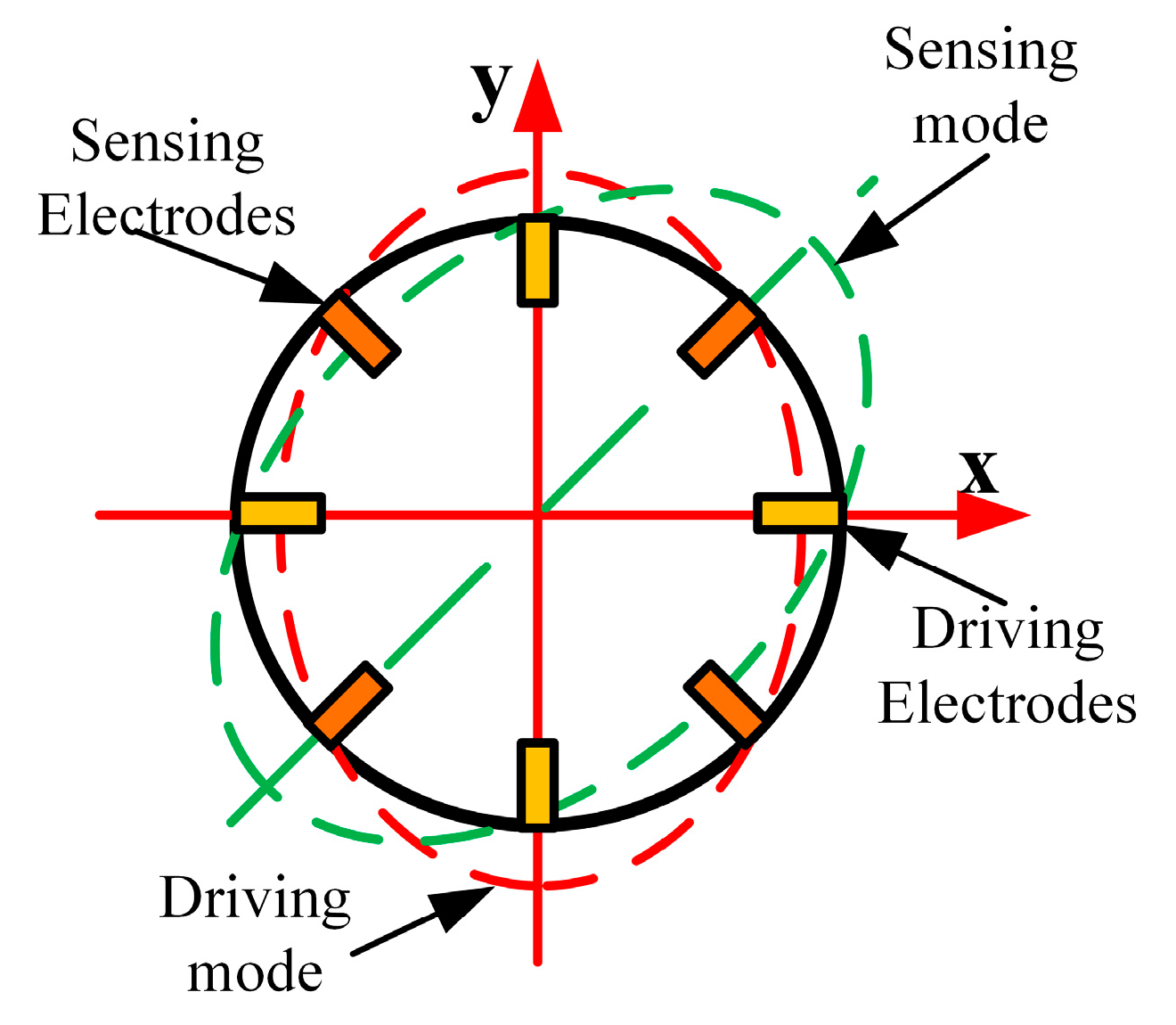

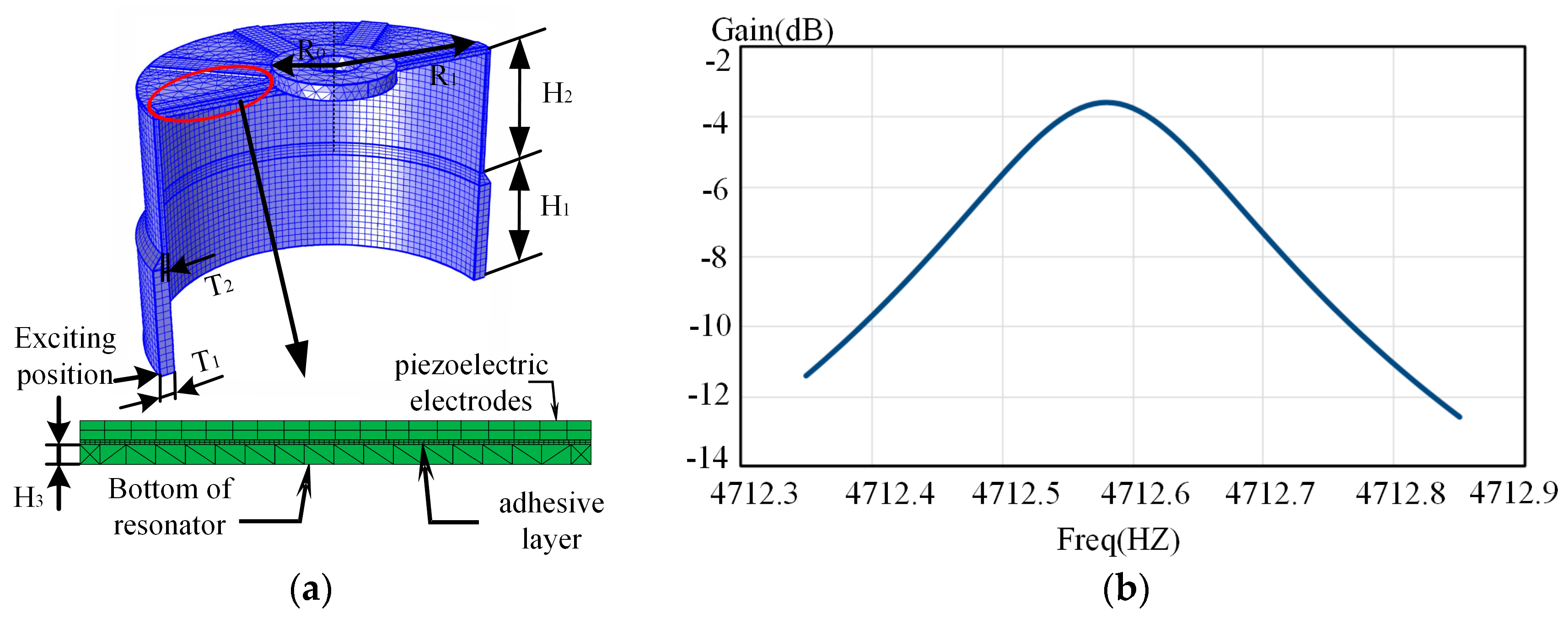
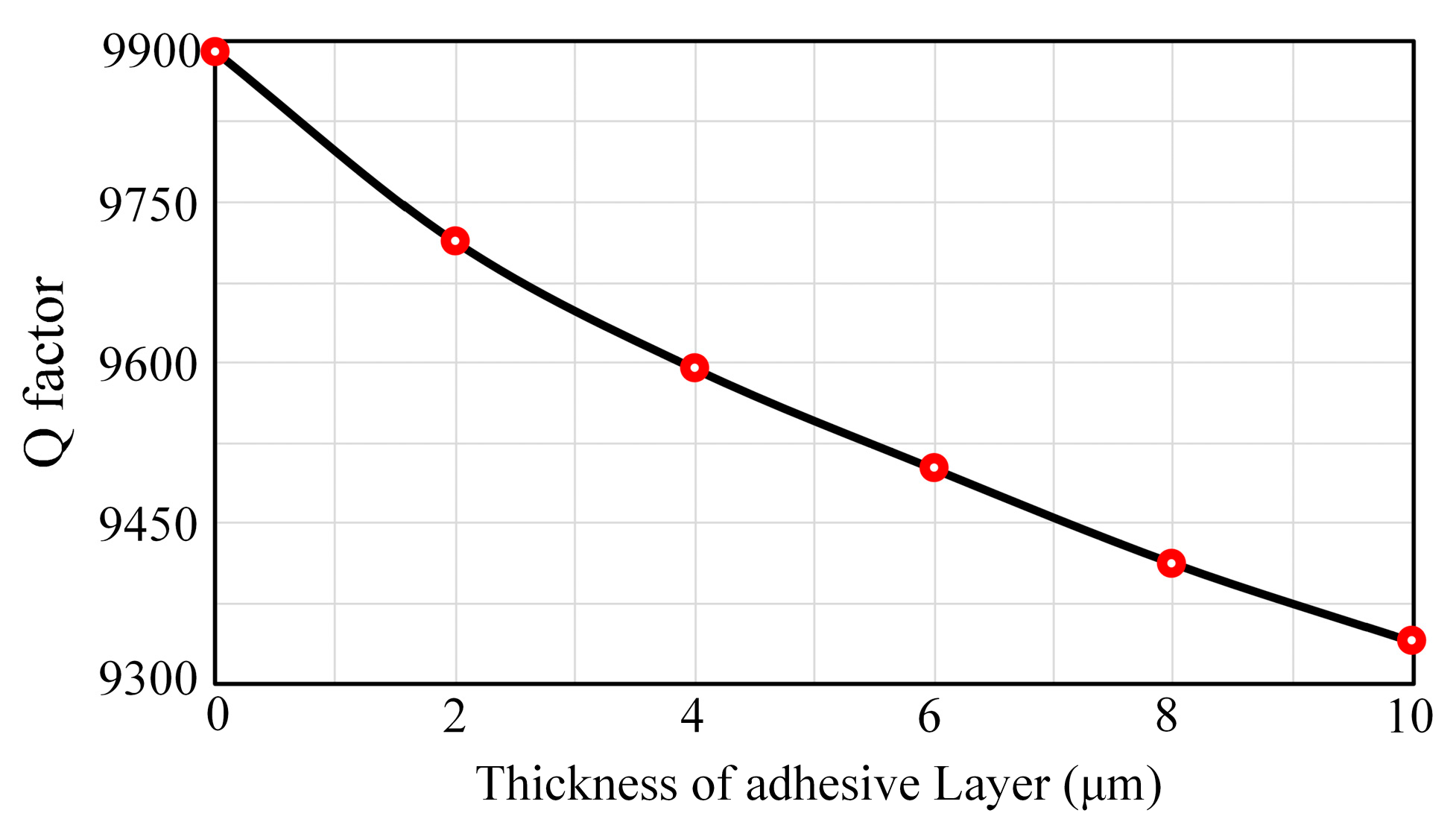

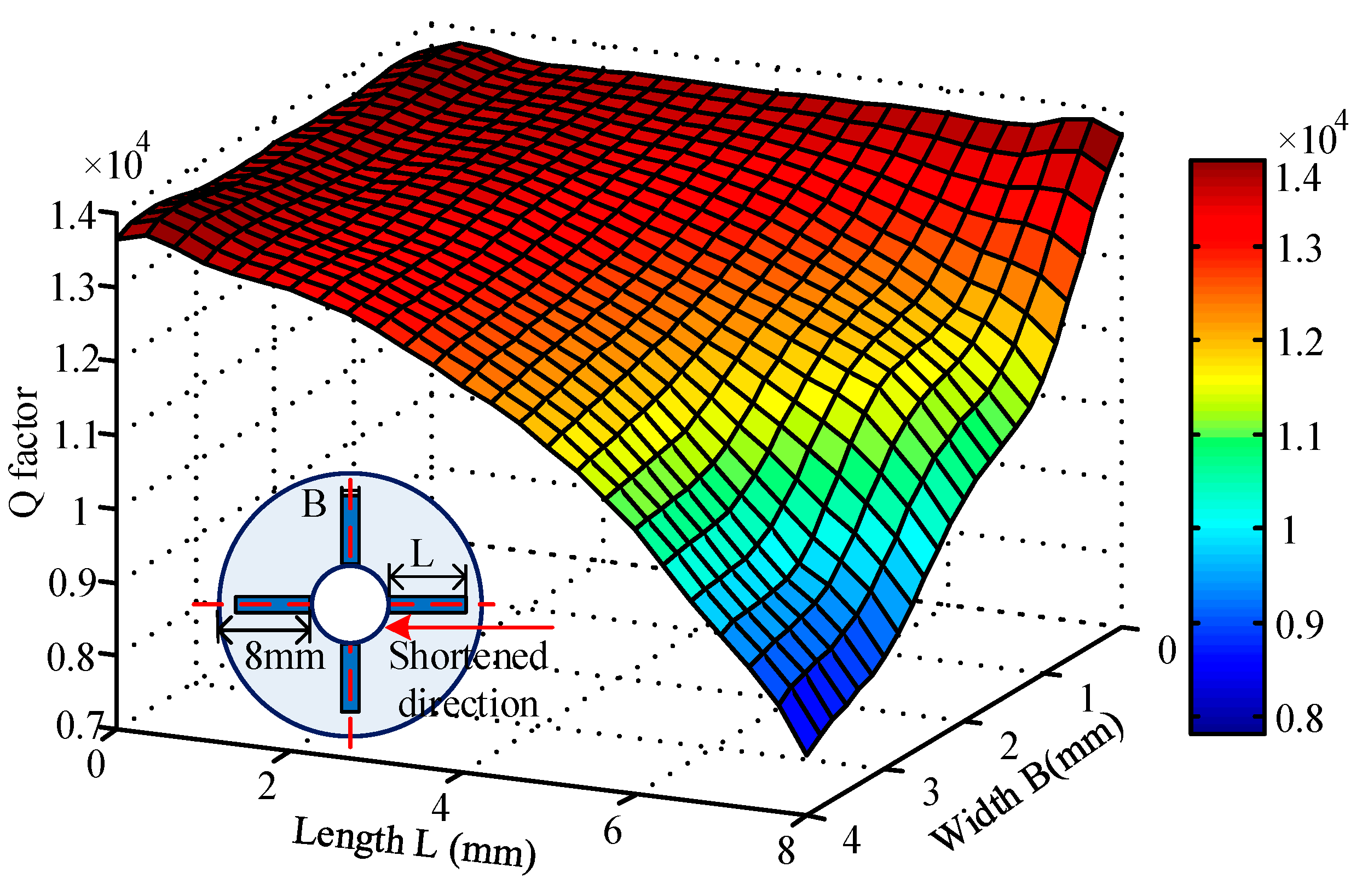

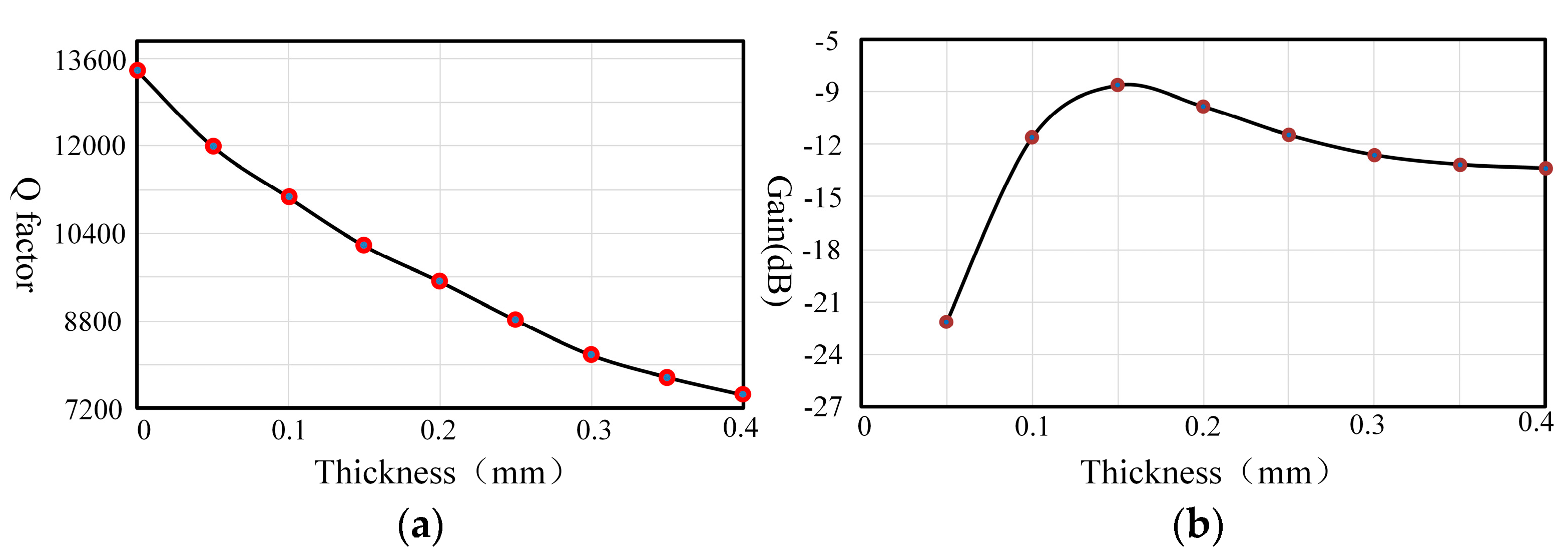

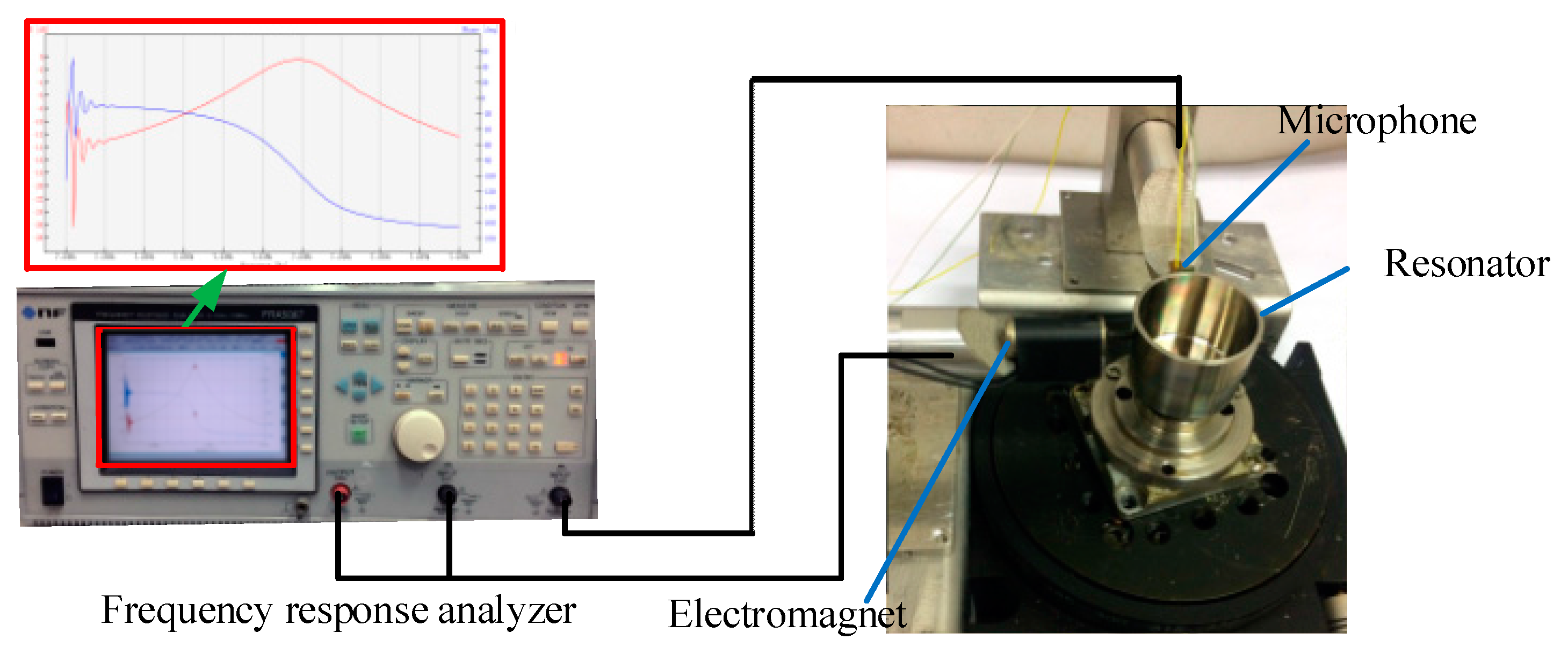



| Name | Density (kg/m3) | Elastic Modulus (GPa) | Poisson’s Ratio | Loss Factor |
|---|---|---|---|---|
| Nickel alloy | 8050 | 206 | 0.3 | |
| Adhesive layer | 1760 | - | 0.38 | |
| PZT | 7500 | 60 | 0.36 |
| Parameter | Value (mm) |
|---|---|
| Height of resonant ring H1 | 8 |
| Height of suspension ring H2 | 10 |
| Radius of substrate R0 | 4 |
| Internal diameter of resonator R1 | 12 |
| Thickness of resonant ring T1 | 1 |
| Thickness of suspension ring T2 | 0.3 |
| Thickness of bottom H3 | 0.3 |
© 2017 by the authors. Licensee MDPI, Basel, Switzerland. This article is an open access article distributed under the terms and conditions of the Creative Commons Attribution (CC BY) license (http://creativecommons.org/licenses/by/4.0/).
Share and Cite
Sun, J.; Wu, Y.; Xi, X.; Zhang, Y.; Wu, X. Analysis of the Damping Characteristics of Cylindrical Resonators Influenced by Piezoelectric Electrodes. Sensors 2017, 17, 1017. https://doi.org/10.3390/s17051017
Sun J, Wu Y, Xi X, Zhang Y, Wu X. Analysis of the Damping Characteristics of Cylindrical Resonators Influenced by Piezoelectric Electrodes. Sensors. 2017; 17(5):1017. https://doi.org/10.3390/s17051017
Chicago/Turabian StyleSun, Jiangkun, Yulie Wu, Xiang Xi, Yongmeng Zhang, and Xuezhong Wu. 2017. "Analysis of the Damping Characteristics of Cylindrical Resonators Influenced by Piezoelectric Electrodes" Sensors 17, no. 5: 1017. https://doi.org/10.3390/s17051017






